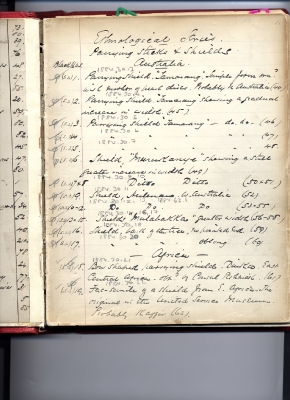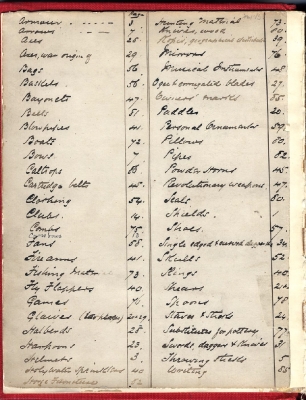There are a small number of bound books in the Pitt Rivers Museum, University of Oxford, said to have come from South Kensington Museum in 1885 with the objects. One of these is called the Black Book (because it was previously bound in black, though it is now bound in red as are other primary documents in the PRM).
Blackwood says of this book (and the similar books called 'Red' and 'Blue' which now are bound together, again in red):
'These two volumes, now bound like the others in the Museum red buckram, were originally notebooks with covers of those colours. They contain (on the right-hand pages) a catalogue of the first and largest batch of specimens sent by General Pitt Rivers to South Kensington, entered in groups according to subject, with consecutive numbers, and (on the left-hand pages) specimens in the same subject groups sent subsequently, with numbers prefixed by Ag. (Aggregation)[1]. ...
It is possible that the following passage gives a clue as to what the Black book actually was. A letter from H.N. Moseley, then in charge of the Pitt Rivers collection at the University of Oxford says:
I want leave to ask one of the S. Kensington authorities to allow one of their superintendents who had charge of the Pitt Rivers Collection to come here for a week to give his services in cataloguing the collection. We to pay his expenses. Such favours are often granted in the case of collections sent to new provinces &c. The man had charge of all the old catalogues of the Museum and has a wide knowledge of the collections and would bring the old catalogues and identify many things the labels of which were mislaid when the collection was shifted in a hurry owing to the University leaving it at Kensington too long. It was determined to ask for this Mr Hill’s services when the things were packed for moving to Oxford. He was then of the greatest use. It is possible the SK people might send him at their own expense.’ [University Archives, UC/FF/60/2/3]
On 19 June 1886 the Secretary of the Science and Arts Department, South Kensington confirmed to Gamlen that Mr Hill's service would be placed at the disposal of the University authorites providing they paid travel and personal expenses. [University Archives, UC/FF/60/2/3] He actually came the week of 18 July 1886 when Moseley and Balfour would be present, ‘I want Balfour to find him a lodging +c and write to him when the time comes.’ [University Archives, UC/FF/60/2/3] Rooms were taken for Hill at Museum Cottage [sic - [University Archives, UC/FF/60/2/3]]
The black book therefore might be one of the catalogues he brought with him. Certainly the timing of the next piece of documentation suggests it might have been. There is a letter in the PRM ms collections from W.J. Hill of the Science Museum (South Kensington Museum) dated 27 July 1886:
With the Secretary's sanction there will be forwarded the two rough manuscript catalogues of objects in the Pitt Rivers Collection. With regard to these I should like to explain that -
(a) The numbered pages were written for the most part from the descriptions furnished, I presume, by General Pitt Rivers on forwarding the first and largest batch of his objects to the Museum.
(b) On the unnumbered pages will be found descriptions of objects received at subsequent dates and some rough notes (generally in brackets) written for my own assistance in identifying objects.
(c) The whole has been put together hurriedly, and was never intended for the service of any but myself and is therefore hardly fit for inspection by those not understanding the circumstances under which the books were written.
They are in fact two notebooks with possibly many errors.
Thanking you for your kindness during my stay in Oxford
I remain,
Yours very faithfully,
W.J. Hill.
So it seems clear that these are Hill's two notebooks (the only doubt is that there are supposed to be three, the so-called 'Black', 'Blue' and 'Red', unless that is the names mean 'Black' and 'Blue/Red') written to help him with the Pitt Rivers Collection whilst it was with South Kensington Museum between 1874 and 1885. However, they are now the best remaining evidence of the contents of the series that are not described in the 1877 catalogue parts 1 and 2.
Here are the links to the pages devoted to all the series contained in the Black Book:
Note that the entries in these lists are mostly matched to the objects either by the match being noted on the object itself (that is Black and then a number physically written on to the object), or because Museum staff in the past have identified the match.
The objects with a clear number (Black 1234 for example) are fairly clearly set in series in the cases specified (if one is specified). Most such instances are listed on the right hand pages of the black book. However, there are lots of additional entries on the left hand page. The explanation for the two lists is given above. For the most part, the tables in the webpages listed above enter these after the more clearly identified series entries. The artefacts listed on the left hand page clearly formed part of the series, so it possible that they were added separately.
The black book has not been straighforwardly transcribed, and it is possible that a few relevant entries have been missed when these pages were re-compiled from the existing Pitt Rivers Museum documentation.
Bibliography for this article
Blackwood, B. 1970. The classification of artefacts in the Pitt Rivers Museum Oxford. Occasional Papers on Technology no. 11 Pitt Rivers Museum, Oxford
Notes
[1] However, entries in the Black book itself suggest Ag might actually stand for 'Agenda'.
AP, March 2011.
[Note: the pencil accession numbers written beside the entries on page 1 of the black book, see the first illustration, were written by the author during the first Leverhulme Trust funded project in the mid-1990s when she was matching entries to the catalogue of the founding collection.]




